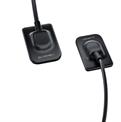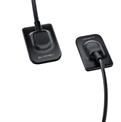
Self priming pumps are the unsung heroes, tirelessly helping liquids travel across various industries. But what happens when the liquid is below the pump, challenging gravity? Traditional pumps struggle, and that's where these types of Centrifugal Pumps come in—a marvel of engineering that ensures a smooth flow.
Understanding These Types of Centrifugal Pumps:
Unlike regular pumps, these types of Centrifugal pumps are independent entities. Their unique design lets them remove air from the suction line and pull liquid upwards on their own, like a thirsty person reaching down to scoop up a drink without help.
How They Work:
These types of Centrifugal Pumps have two main types:
Centrifugal Self-Primers: These pumps use a rapidly spinning impeller to create a vortex, drawing in both liquid and air. An integrated chamber separates the air from the liquid, pushing the air out while keeping the liquid in a continuous loop. This loop acts as a reservoir, ensuring the pump is ready for the next liquid extraction.
Positive Displacement Self-Primers: These pumps use gears, lobes, or vanes to trap and push liquid through the chambers. During priming, trapped air mixes with the liquid and is expelled with it. As pumping continues, air pockets decrease, allowing smooth liquid flow and achieving a self-priming state.
Advantages of These types of Centrifugal Pumps:
Adaptability: They handle situations where the liquid source is below the pump, eliminating the need for complex priming setups.
Mobility: Suitable for mobile applications like firefighting, construction, and agriculture due to their self-sufficiency.
Simplicity: They eliminate the need for manual priming or external sources, saving time and effort.
Dependability: Their sturdy build and efficient functioning ensure consistent performance even in tough conditions.
Various Applications:
These types of Centrifugal Pumps find uses in a wide range of applications:
Residential Use: They help in draining flooded basements and improving water pressure in homes.
Agriculture: Essential for irrigation, field drainage, and fertilizer transfer in agriculture.
Structural Development: Used in tasks like draining excavations, sewage transfer, and supplying concrete mix in construction.
Fire Suppression: High-powered pumps quickly extract water from rivers or lakes for firefighting.
Chemical Sector: They are crucial for transporting hazardous liquids, maintaining fluid circulation in reactors, and controlling wastewater.
Choosing the Right types of Centrifugal Pumps:
Choosing the right Pump is a big deal. There are a lot of options, and it's important to pick the one that fits your needs perfectly. To do this, you have to consider a bunch of things.
First, think about how much liquid the pump needs to move in a certain amount of time. This is called the flow rate. It tells you how fast the pump can push liquid around. Then, there's the lift height. This is how high the pump has to lift the liquid. Both of these factors are crucial in deciding if a pump is right for a specific job.
You also have to think about the liquid itself. Some liquids can be tough on pumps because they're abrasive or corrosive. Different pumps are made for different liquids, so it's essential to know what you're working with. Understanding the liquid helps prevent damage to the pump and keeps it working for a long time.
Now, let's talk power. Pumps need a power source to work. Some run-on electricity, while others use things like gasoline or diesel. Choosing the right power source depends on what's available and practical for where you're using the pump.
Considering all these factors can get complicated. That's why it's smart to get advice from an expert, someone who knows a lot about pumps. A professional can give you useful insights, guide your decision-making, and help you find the perfect types of Centrifugal Pumps for your specific needs. Their advice is like a map, helping you make smart choices, optimize how the pump works, and ensure it keeps running smoothly in different situations.
The Changing Landscape of Self-Primers
These types of Centrifugal pumps play a really important role in the improvement of technology. These pumps are getting better at being efficient, smart, and adaptable. The latest developments, like variable speed control, automatic regulation, and improved materials, make these pumps work better overall.
Now, they come with advanced sensors and monitoring systems that help them gather real-time data. This allows for smart maintenance plans to be put in place. This not only ensures that the pumps work at their best but also reduces downtime by fixing problems before they become big.
These pumps are now equipped with clever features that help them adjust to different situations, making them work really well in real-time situations. As a result, modern types of Centrifugal pumps are not just more reliable and efficient, but they also keep working well for a long time without needing a lot of maintenance. This shows how much of a positive impact technology has on managing fluids in systems.
In Conclusion:
These types of Centrifugal pumps go beyond being mechanical—they are troubleshooters, enablers, and unnoticed heroes in fluid dynamics. Their ability to defy gravity and conquer air pockets makes them invaluable across industries. With adaptability, reliability, and a constant evolution of capabilities, these types of Centrifugal pumps are set to dominate the fluid dynamics domain for years to come.
So, the next time you see a liquid defy gravity and flow uphill against all odds, remember the inconspicuous hero—the powerful these types of Centrifugal Pumps, tirelessly working to ensure the flow never falters.
FAQs
What's special about self-priming pumps compared to regular ones?
Self-priming pumps can pull liquid up by themselves, no extra help needed to start.
Where do self-priming pumps work best?
They're super useful when the liquid source is below the pump, like in firefighting, construction, and farming.
Do self-priming pumps need manual help to start?
Nope, they can start on their own, saving time and energy.
How do self-priming pumps deal with air in the system?
They have clever ways to get rid of the air, making sure the liquid keeps flowing smoothly.
Can self-priming pumps be used in dangerous places?
Yep, they're dependable for moving risky liquids, especially in the chemical industry.
What should I think about when picking a self-priming pump?
Consider how much liquid it can move, how high it can lift, what the liquid is made of, and what powers it.
How do new technologies make self-priming pumps better?
Fancy stuff like speed controls and automatic systems make them work better and let you watch how they're doing in real time.
Can I use a self-priming pump at home?
Absolutely! They're great for fixing flooded basements and boosting water pressure in houses.
Leave a Reply
You Might Like Also

Another Year of Excellence: Celebrating Aajjo’s 9th Annual Day

Witness Hospitality Excellence in Ayodhya Dham & Lucknow: HPMF Convention 2024

7 Tips to Grow Your Business Online














